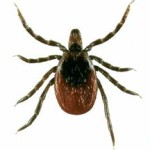About Ticks
 There are over 800 species of ticks and every one of them can carry a significant number of human diseases. A couple of these are Lyme disease and Rocky Mountain Spotted Fever. The wildlife populations that these pests live on are increasing in numbers. This provides more opportunities for ticks to expand in numbers and travel. Along with this, they are not very susceptible to classical agricultural pesticide applications. Interestingly, ticks can not jump or fly. Rather they climb to the top of grass and wait with their front legs extended. When a host walks by they grab a hold and travel with them. If a tick does become attached to your skin, it is very important to remove it immediately. It can not be determined just by looking at a tick whether it has been infected or not.
There are over 800 species of ticks and every one of them can carry a significant number of human diseases. A couple of these are Lyme disease and Rocky Mountain Spotted Fever. The wildlife populations that these pests live on are increasing in numbers. This provides more opportunities for ticks to expand in numbers and travel. Along with this, they are not very susceptible to classical agricultural pesticide applications. Interestingly, ticks can not jump or fly. Rather they climb to the top of grass and wait with their front legs extended. When a host walks by they grab a hold and travel with them. If a tick does become attached to your skin, it is very important to remove it immediately. It can not be determined just by looking at a tick whether it has been infected or not.
Tick Prevention
It is crucial to implement effective pest management programs to prevent any possibility of a tick infestation and prevent it from ever becoming an issue in the first place. Some measures that can be taken to are as follows:
- The most effective strategy is to remove high grass, weeds, and undergrowth from around your home.
- Keep the lawn at a maximum height of 3 inches. By doing so lowers the moisture in the grass from humidity, which makes it difficult for ticks to survive.
- Move woodpiles and birdfeeders as far away from the home as possible. It is not uncommon for birds to attract the unwanted pests and drop them off in your lawn when feeding.
- Keep all trash in tightly sealed bags and ensure the trash cans have a lid cover on them at all times.
- Always check your clothing for ticks after coming inside.
If ticks are encountered in your home, it is very important to call a professional immediately to rid your house of them.

